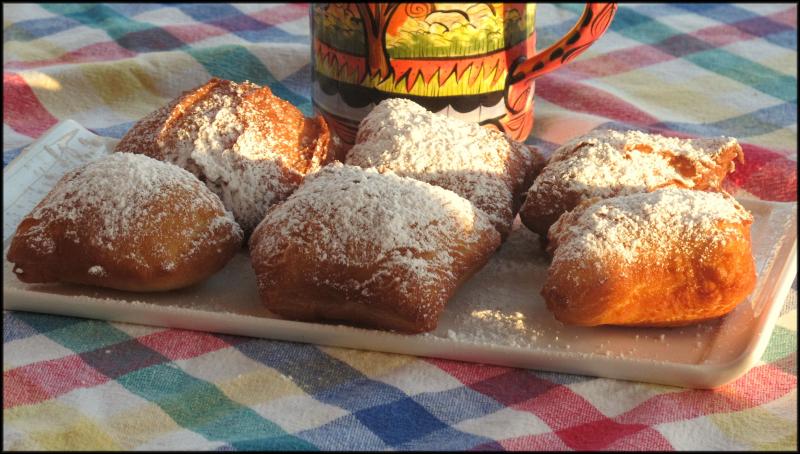Celebrate Mardi Gras with homemade beignets
For those of you who follow the happenings in New Orleans, you’re surely aware that next Tuesday is the final day of the Carnival season. Beginning Jan. 6 and ending with Mardi Gras, cleverly named “krewes” from around the region host nightly parades with elaborately decorated floats, costumed performers and lots of baubles tossed to the crowds lining the streets.
From the French phrase for “fat Tuesday,” the day called Mardi Gras is full of musical parades, fancy-dress balls and exuberant celebrations. The official origin in New Orleans is traced to 1857, largely as a way for the many Catholic residents of the city to prepare for the Lenten season of sacrifice and penitence that begins the following day, Ash Wednesday.
The most iconic food tradition associated with Mardi Gras is the large, colorful brioche-textured cake shaped like an oval crown, called a “king cake.” The name comes from the tiny bean or porcelain doll baked into the cake. Whoever gets the prize in their slice of cake is crowned for the week and will be responsible for providing the following week’s cake.
Early French settlers were the source of this tradition, bringing with them a custom dating back to the Middle Ages in Europe. Another New Orleans favorite also comes from the French, the beignet (pronounced ben-yay). Food historians debate whether we can thank Ursuline nuns who arrived from France in 1727 or the Acadians who came from Canada 30 years later.
The name “beignet” is another unsolved mystery. Are the squares of fried dough named for the Celtic word “bigne” for “to raise”? Or are they named after the Spanish “bunuelos”? No matter the name, the recipe is an old one, dating back to the ancient Roman “scriblita.” This dessert was prepared from a moist dough fried in boiling animal fat, not too far afield from how we made the beignets in the photo.
Beignets start with sweet, eggy, yeasty dough that is allowed to rise, typically overnight. At breakfast time the next day, the dough is rolled out, cut into squares and deep fried. The high moisture content creates steam within the dough as it cooks, resulting in pillowy pastries with a slightly crunchy exterior. As you can see, these are served under a liberal sprinkle of powdered sugar.
I was a little intimidated at the prospect of making my own beignets, but the recipe seemed simple enough. After dinner, I mixed the dough, using just a wooden spoon to combine the ingredients. The dough stayed quite wet, but formed a reasonable ball for its overnight stay in the refrigerator.
The next morning, I filled my mini-fryer with Crisco and set the temperature to 360 degrees. Rolling out the dough was a challenge because it was so wet, it wanted only to wrap itself around the rolling pin. A generous sprinkle of flour solved that problem and I was then able to cut out squares (OK, rectangles) of dough.
Once in the hot fat, they bobbed to the top almost immediately, so I had to turn them a few times to cook evenly on both sides. After a few moments on paper towels to drain and cool slightly, I added the thick layer of powdered sugar. Still not sure if I’d succeeded, I broke open one of the beignets and to my delight found a perfectly airy, tender interior. Happy Mardi Gras!
Beignets
3/4 C warm water
1 pkg dry yeast
1/4 C sugar
1/2 t salt
1 egg
1/2 C evaporated milk*
3 1/2 C flour
2 T vegetable shortening
1/4 C flour (for rolling dough)
oil for deep frying
confectioners sugar
Pour the water into a large mixing bowl; sprinkle with yeast and stir until dissolved. Add sugar, salt, egg and milk; stir to combine. Gradually add first 3 C of flour, mixing the dough with a wooden spoon. Add shortening with remaining 1/2 C flour and continue mixing until smooth. Cover with plastic wrap and refrigerate overnight. When ready to cook, preheat oil to 360 F. Scatter flour onto a work surface and roll the dough 1/8-inch thick. Cut dough into 2 1/2-inch squares and fry a few at a time until puffed and golden, about 3 minutes. Be sure to turn them with tongs as they cook for even browning. Serve while still hot, sprinkled with confectioners sugar. Yield: 30 beignets.
The dough can be kept under refrigeration for up to one week. *Note: do not dilute and do not substitute sweetened condensed milk; you may substitute half & half or light cream.
On the Roberto recipe
An attentive reader called me last week with a question about my recipe for a bean soup named “Roberto.” Although one cup of red wine is listed in the ingredients, it is never called out in the instructions. This is what happens when you adapt a recipe. In the original, the author used dry beans, not canned beans, which I used as a substitution. Her cooking time was therefore much longer, giving the wine plenty of time to cook down. It would seem I never added the wine when I made the soup, but I didn’t remove it from the recipe. So, if you decide to make Roberto, add the wine early and let the alcohol evaporate, or just pour it into a glass and drink it.
























































